Tuesday, August 30, 2005
"Hockey And Airplanes", Steve's Idea Of A Saturday Well-Spent!
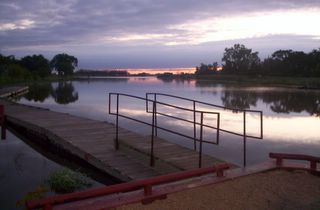
Dawn on the Icelandic River, Riverton.

Saturday, Aug. 27, 2005. I was up early, due to the "Bush Pilot Alarm Clock" that rings off in my head every 4 AM. Today I was taking my son to a hockey camp in Gimli, for Bantam-aged prospects for the Interlake Lightning Midget "AAA" Hockey Team. We left home early, and headed for the rink.
I love hockey rinks, especially the smell, first thing in the morning. Looking at the fresh ice, before there is a blade mark on it, seeing the clock turned on, and watching the young lads "hit the ice", to me, is time well-spent. Anyways, all the boys were quite talented, and the coaches put them through some intensive drills. After an hour and a half, the boys were spent and would receive a 3 hour break before the next session on ice. We had lunch, and looked for an interesting place to kill some time. Guess where we went?
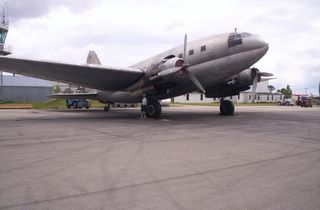
Shane underneath Curtiss Commando C-46 C-GIBX!

I have posted previously about C-GIBX and sister ship C-GTPO, including this spring, when both aircraft were missing engines. Read about them here, Spring!! Finally!! These aircraft are owned by FNT First Nations Transportation Inc.. The aircraft serve communities in northern Manitoba and Ontario, hauling massive amounts of freight. We wanted to get a look inside, and were escorted by a FNT employee. So, how do you get over-sized freight "up north"? In a "C-46", of course!
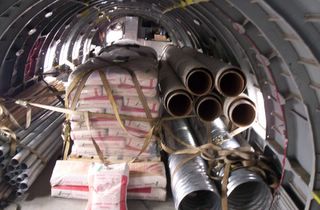
A typical C-46 load, looking from the cargo door towards the cockpit.


Look at this cockpit, WWII-era vintage! This is a real,
working airplane. What a beautiful sight!!

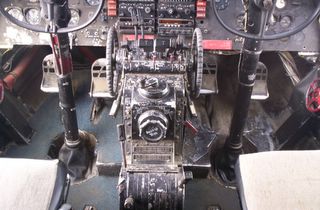
Love that control-quadrant!

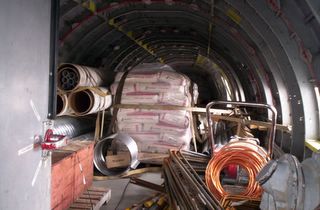
A view from the cockpit rear-ward.............


As we exited C-GIBX, a Canadair CL-215 belonging to the Manitoba Government taxied by.............

I knew that FNT Transport owned a Douglas DC-3 also, but had never seen it. So, Shane and I went looking for it, and didn't have to go very far!
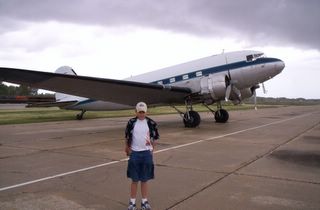
Shane scowls and faces into the wind from a "squall" that blew through while we were on the apron, in front of beautiful DC-3, CF-FTR!!

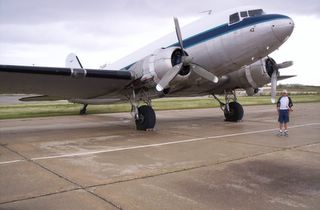
I love these old airplanes. Big tail-draggers with radial engines!

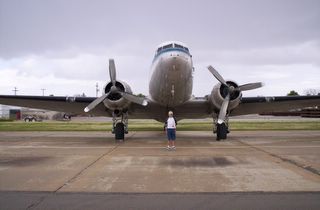
Not as big as the C-46, but nonetheless a thing of beauty!


Two of my favourite "specimens"............

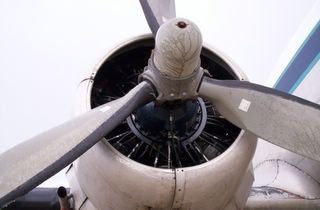
The DC-3 had two 895kW (1200hp) Pratt & Whitney R1830S1C3G Twin Wasp 14 cylinder twin row radial piston engines driving three-blade variable pitch propellers, or two 895kW (1200hp) Wright SGR1820 Cyclone nine cylinder radials. These are the Pratt and Whitney 1830s.

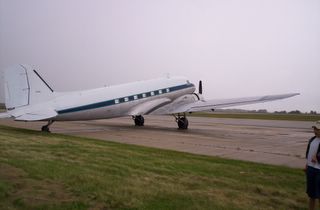
Technology 70 years old. I would love to fly it, and make noise, and spew oil!

DC-3 SPECIFICATIONS
Powerplants
Two 895kW (1200hp) Pratt & Whitney R1830S1C3G Twin Wasp 14 cylinder twin row radial piston engines driving three blade variable pitch propellers, or two 895kW (1200hp) Wright SGR1820 Cyclone nine cylinder radials.
Performance
Max speed 346km/h (187kt), economical cruising speed 266km/h (143kt). Initial rate of climb 1130ft/min. Range with max fuel 2420km (1307nm), range with max payload 563km (305nm).
Weights
Typical operating empty 8030kg (17,720lb), max takeoff 12,700kg (28,000lb).
Dimensions
Wing span 28.96m (95ft 0in), length 19.66m (64ft 6in), height 5.16m (16ft 12in). Wing area 91.7m2 (987sq ft).
Capacity
Flightcrew of two. Seating for between 28 and 32 passengers at four abreast or 21 three abreast.
Production
10,655 built in the USA, including 430 for commercial operators prior to US entry to WW2. 2000 or so built in Russia under licence. More than 400 remained in commercial service by 1998.
--------- ----------- -----------------
Then Shane and I figured, if we looked hard enough, we might find an old relic somewhere around the airport. Sure enough, it didn't take us long to find................
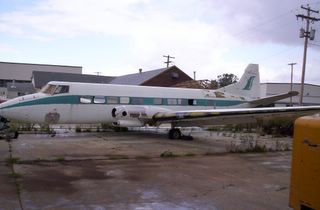
A Saunders ST-27 carcass!

The Saunders ST-27 was a deHavilland Heron converted by Saunders Aircraft of Gimli, Manitoba, in the 1970s. Modifications to the aircraft included lengthening the fuselage and replacing the Heron's four Gypsy piston engines with two Pratt and Whitney turbines. The aircraft had (2) 770 HP Pratt & Whitney PT-6 turboprop engines with a cruising speed of 211 mph and a maximum range of 986 miles. The Saunders ST-27 is 58' 10" long and has a wingspan of 71' 6". Only 14 were ever produced, as financial backing dried up. Too bad.

Empty nacelles where the "Pratt" turbines should be............

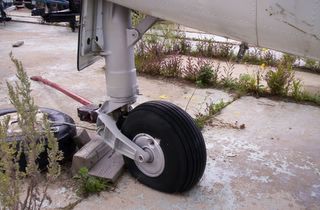
Quite "skookum" nose-gear!

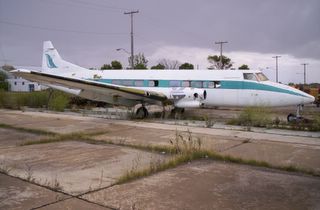
Actually, a very sleek-looking airplane.

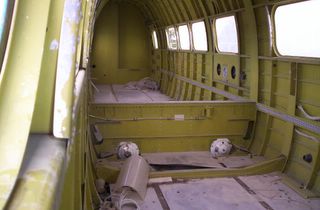
Interior looking rear-ward, still in zinc chromate primer...

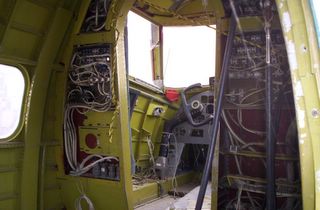
Cockpit bulkhead..........

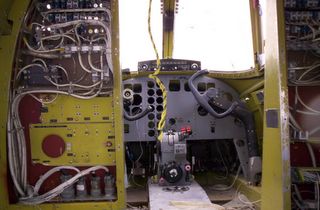
Looking in the unfinished cockpit.............

I looked at my watch. "Holy shit, Shane, let's head for the rink"! We burned rubber, and Shane dressed for his second session on the ice that day!
Anyways, Shane played in 2 inter-squad games Sunday, and it was a great experience during the weekend. I love the old radial-engined airplanes, and long for the days when the skies were full of them. As I sit and type, I must admit, this past weekend was time well-spent!
Till next time...........
"Kaun ba bi"!
Comments:
<< Home
Hi Steve
I'm a collector of Heron And Saunders pictures, and to my opinion, that old aircraft at Gimli is the one and only ever built ST-28. Please look also
http://www.airliners.net/open.file?id=0172613
Thanks for the detailed pictures!
Martin
I'm a collector of Heron And Saunders pictures, and to my opinion, that old aircraft at Gimli is the one and only ever built ST-28. Please look also
http://www.airliners.net/open.file?id=0172613
Thanks for the detailed pictures!
Martin
Hi Martin! I wasn't aware of that, and tried finding
pics of another ST-28 and couldn't find any online.
What was the difference between the -27 and -28?
Different engines?
Cheers,
Steve
pics of another ST-28 and couldn't find any online.
What was the difference between the -27 and -28?
Different engines?
Cheers,
Steve
Now I've got an answer in a forum:
The ST-27 was a re-engined version of the Heron with PT-6A-27 turbine engines rated at 715 e.s.h.p
The ST-28 had PT-6A-34 engines rated at 783 e.s.h.p and was partially pressurised with an increased operating weight. The sole ST-28 was converted from Heron c/n 14087. This was the thirteenth Heron.
The source for the information is De Havilland Aircraft since 1909 by A J Jackson published by Putnam which contains a list of all the aircraft involved
__________________
Dave Charles
Bye, Martin
The ST-27 was a re-engined version of the Heron with PT-6A-27 turbine engines rated at 715 e.s.h.p
The ST-28 had PT-6A-34 engines rated at 783 e.s.h.p and was partially pressurised with an increased operating weight. The sole ST-28 was converted from Heron c/n 14087. This was the thirteenth Heron.
The source for the information is De Havilland Aircraft since 1909 by A J Jackson published by Putnam which contains a list of all the aircraft involved
__________________
Dave Charles
Bye, Martin
Thanks, Martin! I figured it must have been an engine upgrade. Too bad there were only 13 made, as a de Havilland airframe is "robust" like none other!
Steve
Steve
Hi Steve,
I want to build up a webside about Saunders Aircraft and found your photos. Maybe it is possible that I may use them ? It would really be nice to get ur permission !
My mail is: marc.volland@gmx.net
Maybe you have taken more photos ?
Marc
I want to build up a webside about Saunders Aircraft and found your photos. Maybe it is possible that I may use them ? It would really be nice to get ur permission !
My mail is: marc.volland@gmx.net
Maybe you have taken more photos ?
Marc
Hi Gents,
I worked a Otonabee Airways/Air Atonabee when the ST-27's came and when Joe and Bea Csumrik purchased the assets of Saunders Aircraft and moved them to Peterborough. I left and went off to Air Canada just before Victor Popalardo (sp?) purchased the company and it became City Express. I have a ST-27 manual that was being updated to the ST-28. Unfortunately I don't have much else. I wish I still had pictures. I'll see what I can dig out.
Dale
I worked a Otonabee Airways/Air Atonabee when the ST-27's came and when Joe and Bea Csumrik purchased the assets of Saunders Aircraft and moved them to Peterborough. I left and went off to Air Canada just before Victor Popalardo (sp?) purchased the company and it became City Express. I have a ST-27 manual that was being updated to the ST-28. Unfortunately I don't have much else. I wish I still had pictures. I'll see what I can dig out.
Dale
Hi There
If you are looking for info on the ST-28's I have it still in files. Just email me at csumbus@sympatico.ca.
I still know where some of the AME's are.
Cheers
Deb Csumrik
If you are looking for info on the ST-28's I have it still in files. Just email me at csumbus@sympatico.ca.
I still know where some of the AME's are.
Cheers
Deb Csumrik
I was working at Saunders Aircraft 1974 to 1975.The 13th Heron to be converted was designated as the ST 27B at the time of its first test flight and was the prototype for the ST28. The ST 28 was never built and we were working on the tooling for this when funding was withdrawn. Feel Free to contact me by email.
trevorwoodley@hotmail.co.uk
trevorwoodley@hotmail.co.uk
HI, I'm looking for a 3 view draing of the ST-27 or ST-28 so we can build a r/c model from it.
thanks - ken kalynuk, winnipeg
Post a Comment
thanks - ken kalynuk, winnipeg
<< Home



















